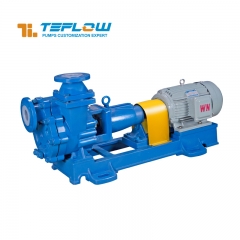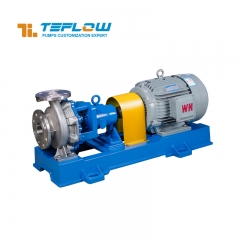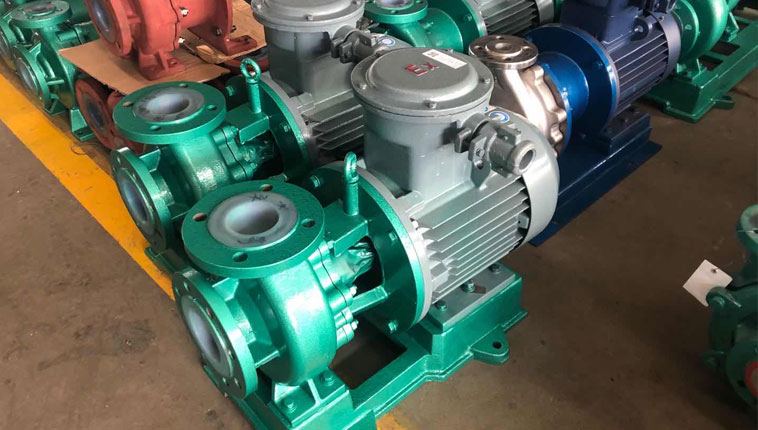In chemical production, chemical pumps often transport corrosive, high-temperature, and particulate-laden media, making the reliability of their mechanical seals crucial. Mechanical seal flushing systems significantly extend seal life and reduce leakage risks by cooling, lubricating, and purifying the seal cavity, ensuring stable operation of chemical pumps.
一、Common mechanical seal flushing solutions (API 682 standard)
1.Internal flushing solution (suitable for cleaning media)
Flushing directly utilizes the pumped medium, eliminating the need for an external system and reducing costs. API Plan 11 (single seal) draws the medium from the pump outlet, through a restrictor orifice, into the seal chamber, and then returns to the inlet. It is suitable for clean media at room temperature (≤120°C) and pressure (≤1.6 MPa), such as water and ethanol, but is not suitable for media containing particles or prone to crystallization. API Plan 13 (double seal) operates on a similar principle and is suitable for dual seals. It is used for conveying clean and flammable media requiring dual protection.
2.External flushing solution (suitable for harsh media)
An external cleaning auxiliary medium is required to isolate the influence of severe working conditions. API Plan 21 (external cooling) introduces circulating water, etc., and indirectly cools the sealing chamber through a cooling jacket. It is suitable for high-temperature clean media of 120-350°C, such as hot oil. It is necessary to ensure that the auxiliary medium is compatible with the pump medium. API Plan 23 (external injection) uses nitrogen and other gases to directly spray the sealing surface to purge particles. It is suitable for normal temperature media containing a small amount of particles (0.1%-1%). The auxiliary medium needs to be dry. API Plan 32 (external purification) introduces high-pressure media into the double-face seal isolation chamber to prevent the pump medium from entering. It is suitable for high solid content (>1%) and highly corrosive media, such as mud and concentrated hydrochloric acid.
3.Special working conditions solution
API Plan 52 (Nitrogen Isolation) injects dry nitrogen into the isolation chamber. It is suitable for ultra-low temperatures (<-40°C) or flammable and explosive media, such as liquid ammonia, and requires a pressure stabilizer. API Plan 53A/B (pressurized liquid isolation) uses pressurized tanks to inject high-pressure liquids. It is suitable for ultra-high pressure (>10MPa) or cavitation-prone conditions. A is manual liquid filling and B is automatic liquid filling.
二、Flushing plan selection method
The core of selection is "working condition matching", which is divided into four steps:
1.Consider the medium characteristics: if the solid content is less than 0.1%, select internal flushing (Plan 11/13); if it is 0.1%-1%, select external flushing (Plan 23); if it is greater than 1%, select isolated external flushing (Plan 32/53A/B); for high temperature (>120°C), select external cooling (Plan 21) or isolated flushing (Plan 52/53); for highly corrosive media, select double-end face + isolated flushing (Plan 32/53); for flammable and explosive media, select nitrogen isolation (Plan 52); for easy crystallization, select continuous flow flushing (Plan 21/32).
2.Matching operating parameters: For low pressure (<0.5MPa), use internal flushing (Plan 11); for high pressure (>1.6MPa), choose double seal + pressurized flushing (Plan 53A/B); for negative pressure, choose external pressurized flushing (Plan 53B); for high speed (>3000r/min), enhanced cooling is required, such as Plan 21 with dual cooling jackets, or Plan 32 with increased flushing flow (to avoid excessive accumulation of frictional heat).
3.Combined seal type: Plan 11 (internal flushing) and Plan 21 (external cooling) for single-end seals, and isolated flushing solutions (Plan 32/52/53A/B) for double-end seals.
4.Consider economic efficiency: choose low-cost internal flushing for normal working conditions and customized solutions for extreme working conditions, while taking into account the convenience of operation and maintenance.
The selection of a flushing solution for a chemical pump's mechanical seal is a process of adapting to the working conditions. The core is to start from the medium characteristics (solid content, temperature, corrosiveness), combine the working parameters with the seal type, and balance reliability and economy. A correct flushing solution can significantly extend the life of the mechanical seal and is the guardian of the stable operation of the chemical pump.





 +86 18130251359
+86 18130251359 teflowpumps@tlpumps.com
teflowpumps@tlpumps.com











 +86+0563-5093318
+86+0563-5093318
